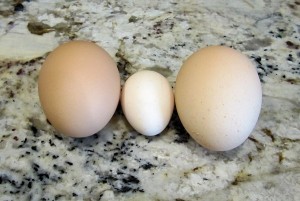When we got the new red chickens in January, I figured that the first week in June we would start getting eggs from them and sure enough, Thursday we got our first egg. A “pullet” is simply a young hen and the first eggs they lay are called “Pullet Eggs”. They’re usually quite small for a few weeks, then they seem to get huge and often have double yolks for a few weeks, then they even out and are consistent in size. Depending on the breed of chicken, just as some chickens lay brown, very dark brown, coral, white or blue/green eggs, the breed most often determines the size of the eggs also.
My Dominique chickens lay a medium light tan egg, while my red hens lay very large dark tan eggs.
The egg in the middle is a “pullet egg” from one of the new red hens while the two eggs on the outside are eggs from the only two laying old red hens that I have left.
The large egg is 76 grams, or 2.68 ounces. The red chickens lay eggs anywhere from about 2.5 ounces to a little over 3 ounces. With grading for grocery store eggs, 2.5 ounces and over are considered jumbo eggs.
The small egg is 20 grams, or .7 ounces. Huge difference! By this time next week, the new chickens will all be laying at least medium sized eggs and probably by the next week, I’ll be getting a few double yolkers.
Sometimes, the tiny pullet eggs will have only the white and no yolk at all but this one had a yolk. I know because as soon as I weighed it, I dropped it and it broke, which reminded me of Chad’s Egg Letter from quite a few years ago.
Double yolk eggs are produced when two yolks are produced too close together and end up being enclosed within the same shell. For anyone wanting a bit more details on egg production, here’s a good article at Backyard Chickens.
Sometimes when chickens get near the end of their egg laying cycle, they will lay double yolkers too. It’s kinda like . . in the beginning, their hormones are all screwed up and they don’t quite have it all figured out yet and too many yolks go into the eggs and in the end, they’re sick of laying eggs and begin dumping all the yolks just to get the egg laying years behind them!
You’ll never look at eggs the same, will you?




Vivian says
Well, that made me chuckle. Kind of like females going through menopause.
JudyL says
Yep, I thought about that too! This morning there was an egg in the egg box without any shell at all. This week, from those new hens, I’ve had “rubber” eggs (which have a shell about the consistency of a balloon), tiny eggs, an egg with no shell . . they’re using every tricks in their pullet book of tricks! 🙂
Frankie says
Soon you’re going to have an abundance of eggs from all those chickens — have you ever dehydrated them? I have 1 hen that never did get as big as her “sisters” and her eggs are consistently small. Whoever brings in the eggs during the day will announce “there’s a Miranda egg” because we all know those little ones are hers. 🙂
SaraF says
so interesting to read about the egg production process. Recently I bought a dozen jumbo eggs to make deviled eggs and had 5 double yolks out of the dozen eggs. Now I have a better understanding of how that happens.
PatMcg says
The chicken stories bring fond memories of when we lived in the country and our girls were young. Then I think maybe we should get a few chickens but luckily reality kicks in. Do miss those bright yolks though.
Sherrill says
Judy, your blog is so interesting AND educational!! Really enjoy all the new info I often find here.
Jannette B says
We had chickens when we were on the farm, and the oddest thing that we ever had was an egg (shell, egg white and yolk) with a complete egg inside it – shell and all.. We didn’t crack it to see what was inside the inner egg, but they usually don’t have a yolk. I’m always surprised at what interesting things lurk inside that shell!
Joyce says
I remember being in awe when we would find a double yolk in an egg when I was growing up. I don’t remember seeing one for many years now. I guess the farms that supply eggs to the grocery stores cull out the older chickens.